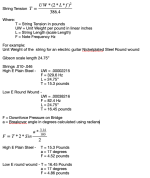cannibal animal
New member
- Joined
- Feb 20, 2007
- Messages
- 121
screw the tail piece right into the guitar and top wrap your strings the angle is so easy, theres no tension against the bridge, no slipping, no string breakage....it is superior.
No, no, no!Here's where necks get twisted. The stop bar is a tension device. Uneven tension from side to side will cause strings on one side of the neck to be tighter than the strings on the other side of the neck if the stop bar is higher on one side than the other.
No, no, no!
There are two definitions of "tension", and as they both get used in these discussions it can get confusing. One definition, the strict 'scientific' one, refers to the pull along the length of the string. This tension will be the same for any string diameter, neck length, and pitch. Changing the height of the tailpiece will have no effect on it assuming you slack the strings before making a change and retune to pitch afterwards.
The other meaning of "tension", the more common one, refers to how much force to takes to move a string sideways. It's been suggested this be referred to as "compliance" for the sake of clarity. This is dependent on the length of the neck and how much extra string is beyond the nut and saddle as well as how much friction there is over the nut and the saddles.
It's this second meaning, the compliance, that changes when you change the height of the tailpiece. As long as you tune to pitch each time, there will be no change in the tension on the neck.
All that does is increase the tension between the stop bar and the bridge, it can't possibly affect the tension between the bridge and the nut you may think that it's easier to bend strings but that's purely in your mind.. It can't it's the same as the top wrapping myth..I like the stopbar to be fairly high. The angle of strings on the bridge is the same as on my headstock (i have Norlin era Custom, which does have lower headstock angle). The strings are lighter to bend to me and the sound is more detailed and fat with some honk.
I used to think that and I believe you took the same Geometry and Physics classes I did.All that does is increase the tension between the stop bar and the bridge, it can't possibly affect the tension between the bridge and the nut you may think that it's easier to bend strings but that's purely in your mind.. It can't it's the same as the top wrapping myth..
So you believe the string tension on the unwound strings is the same as the wound side?Here's where necks get twisted. The stop bar is a tension device. Uneven tension from side to side will cause strings on one side of the neck to be tighter than the strings on the other side of the neck if the stop bar is higher on one side than the other.
If the stop bar is causes uneven tension across the neck, over time, the strings will pull the neck in the direction of the tighter strings. You will see the nut and headstock "dipping" in the direction of the tighter strings.
The same effect will happen to a guitar with an even tailpiece but strings not tuned to pitch evenly.
Guitars that have been stored a long time with missing strings on one side and tight strings on the other will do this. That is when it is time to go to the repair shop.
So find the sweet spot and keep checking the neck relief to look for signs of high and low spots.
EDIT : Here is the D'addario research and has the Physics behind String Tension.
String tension
Two things.All that does is increase the tension between the stop bar and the bridge, it can't possibly affect the tension between the bridge and the nut you may think that it's easier to bend strings but that's purely in your mind.. It can't it's the same as the top wrapping myth..
Hey there Mike,So you believe the string tension on the unwound strings is the same as the wound side?

This does not appear to be correct. (But please, correct me if I've overlooked something!)...if the change in the break angle over the bridge to the stopbar is different across the strings uneven string tension affects guitar necks.
This is correct.If the strings are not tuned to pitch or actually missing there will be uneven pressure on the guitar neck.
Yup. - Exactly.Yeah that brings up an interesting question. If the hie E, B, and B would be top wrapped and the D, A and Low E through the stop bar, the break angle would be much lower than the D, A, and Low E. That means the downforce tension would be lower on the high strings making bending them easier?